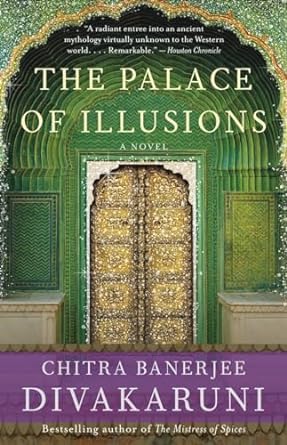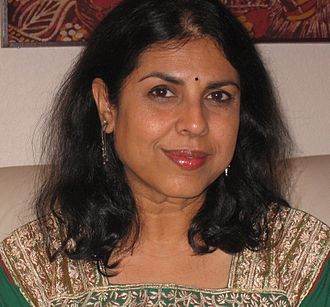Panchali becomes her name when she is married to Pandavas, Draupadi is who she was born from the fire, and was full of fire. Draupadi is mostly recognised as the wife of Pandavas but now is the time to give her the identity of Draupadi.
Chitra Banerjee Divakaruni’s “The Palace of Illusions” throws new life into the ancient Indian epic Mahabharata. Instead of the typical male-centric story, Divakaruni gives voice to Panchaali, the fiery queen also known as Draupadi. Divakaruni’s story provides a striking feminist critique of the patriarchal institutions that generally rule the epic and society.
Challenging the Male Gaze in The Palace of Illusions
Panchaali has traditionally been depicted in the Mahabharata as a lovely woman who is the prize for winning the epic swayamvara. Divakaruni deconstructs this one-dimensional picture by digging into Panchaali’s inner world. Her fears and desires are revealed in passages such as when she confesses to her friend, “Dread coiled in my stomach… a knot of apprehension that tightened with every booming laugh, every assessing glance.” This private monologue deviates from the typical focus on the guys vying for her hand. Instead, we observe Panchaali’s agency and her yearning for a certain type of husband.

Divakaruni’s critique extends beyond the physical. Panchaali is regarded not only for her beauty but also for her keen intelligence and smart thinking. For example, when presented with the duty of selecting a husband via a trick archery tournament, Panchaali immediately recognises the strategic advantage it provides to the least proficient archer, Yudhisthira. This highlights her intelligence, which is often ignored when women are only observed via the male gaze.
Divakaruni’s use of these strategies effectively dismantles the male gaze in “The Palace of Illusions.” She creates a Panchaali who is not only stunning, but also intelligent, strategic, and emotionally complicated. This shift in perspective enables readers to connect with Panchaali on a deeper level, challenging the objectification of women in literature.
Nuances of polyandry
In The Palace of Illusions, the portrayal of polyandry, as more than just a societal norm. She goes into Panchaali’s emotional challenges inside this structure. We see her manage intimacy with five spouses, societal expectations to create offspring and potential jealousy. This calls into question the notion that polyandry inevitably leads to promiscuity. The work initiates a discussion about societal conceptions surrounding female sexuality by contrasting it with society’s ideals of female monogamy. Furthermore, investigating the historical context of polyandry enhances the understanding.
Furthermore, Panchaali’s voice is central. Divakaruni describes her challenges and accomplishments within the system. Does she have moments of happiness? Does she ever rebel? By focusing on Panchaali’s perspective, the story emphasises the human cost of cultural conventions and challenges how female sexuality is frequently perceived.
Beyond the monolithic wife
Divakaruni’s feminism goes beyond a mere challenge to masculine domination. She understands the subtleties of patriarchy. Despite her status as queen, Panchaali is limited by her gender. The situation of lowered caste women, such as her maid, serves as a reminder that oppression manifests differently for women from different socioeconomic groups. This intersectional approach improves the story by emphasising the diverse nature of power dynamics.

Panchaali’s love life also serves as a platform for feminist study. The concept of polyandry, which is frequently used to portray her as promiscuous, takes on new significance. Divakaruni portrays it as a societal norm, delving into Panchaali’s challenges with emotional intimacy and social pressures. This calls into question the double standard that exists for male and female sexuality.
Furthermore, Panchaali’s affection for her husbands is not a single thing. Each relationship is fashioned by their personalities, demonstrating her multidimensional nature and challenging the idea of a monolithic “wife” image. Finally, “The Palace of Illusions” empowers women by giving Panchaali a voice and reclaiming her story.
The power of Panchaali’s voice
By giving Panchaali a voice, Divakaruni reclaims the story. We see the impacts of war not only on the battlefield but also on the women who remain behind. Panchaali’s sorrow, perseverance, and views highlight the human cost of conflict. This move empowers female readers by allowing them to identify with a strong female character and recover their proper place in the larger narrative.
The Palace of Illusions is more than just a compelling retelling; it’s a call to action. It inspires us to challenge conventional norms and strive for a society in which women are recognised as complicated beings with their aspirations, voices, and stories, rather than as objects. It’s a strong reminder that even in the face of adversity, the human spirit perseveres, especially when women are given the freedom to speak their truth. This book is a must-read for anyone looking for a new take on an ancient epic, as well as a gripping story with a strong feminist message.
The cycle of violence and the longing for peace
The Mahabharata is a story of battle and revenge. Panchaali is a central character caught up in this terrible cycle. She feels enormous sadness and loss after witnessing the brutality firsthand. Panchaali is portrayed by Divakaruni as someone who seeks peace and reconciliation rather than revenge.
Despite her anger and hurt, she expresses a yearning for a new path, a world where disputes are resolved without violence. The novel is a critique of the celebration of violence, emphasising the human cost, particularly for women, who are frequently the victims of societal conflicts. Panchaali’s wish for peace is a powerful counterweight to the catastrophic forces at play.
The Palace of Illusions and the value of female solidarity
While the story highlights Panchaali’s relationships with her husbands, it also emphasises the value of female friendships. One such friendship is with Draupadi, a maidservant who serves as a confidante and source of support. Panchaali finds a secure area to express her fears and frustrations throughout their chats. Their relationship exemplifies the strength of female solidarity in a patriarchal environment.
Having another woman to confide in and rely on helps Panchaali manage the difficult world around her. The novel emphasises that women are not separate beings, but can find strength and comfort in their relationships with one another.
Through Panchaali’s eyes, we see the emotional cost of war, the complications of polyandry, and the constraints placed on women in a patriarchal society. Divakaruni breaks down the “male gaze” by digging into Panchaali’s inner world, showing her desires, fears, and strategic intellect.
The story celebrates the strength of female solidarity while also challenging the double standard that applies to female sexuality. Finally, The Palace of Illusions empowers women by granting Panchaali a voice and reclaiming her story. It’s a call to action, asking readers to question established norms and fight for a society in which women are viewed as human beings with voices and stories to tell, rather than as just objects.
About the author(s)
With a passion for storytelling and a keen interest in human behavior, Iti Dewangan is currently honing her skills in journalism, psychology, and English Literature. Having contributed to esteemed organizations like The Wire, Iti is dedicated to amplifying voices, uncovering truths, and making a positive impact through her writing. With a vision to become a respected journalist, she endeavors to navigate the ever-evolving media landscape with integrity, empathy, and a commitment to truth.





